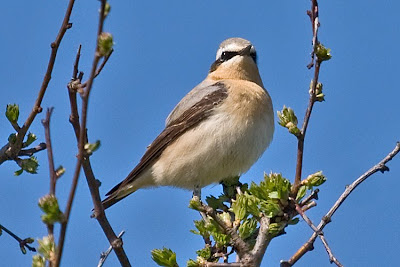Most birders will have a favourite spring migrant, mine is the Willow Warbler. This is a bird that, when it arrives, seems to be the real herald of spring, a sign of the annual renewal of life.
 But what ever that favourite is there can be few who wouldn't agree that on the coast of Kent the Wheatear is a real icon of the migration season. It really does epitomise the wonder of migration. Moving from the northern breeding range to sub-Saharan Africa for the winter they are prominent on both directions of their travels.
But what ever that favourite is there can be few who wouldn't agree that on the coast of Kent the Wheatear is a real icon of the migration season. It really does epitomise the wonder of migration. Moving from the northern breeding range to sub-Saharan Africa for the winter they are prominent on both directions of their travels. Of course the spring birds are often the brighter males, very striking in their breeding plumage, whereas in autumn the majority are much duller young birds. Wheatears are most often seen of the ground, feeding actively on invertebrates that they find as they dash around, frequently showing their white rumps . Often they use posts as look out perches.
Of course the spring birds are often the brighter males, very striking in their breeding plumage, whereas in autumn the majority are much duller young birds. Wheatears are most often seen of the ground, feeding actively on invertebrates that they find as they dash around, frequently showing their white rumps . Often they use posts as look out perches. The first bird I found today was using the fence around the Freedown to watch for prey items and then dropping down for short sorties into the sheep mowed grass.
The first bird I found today was using the fence around the Freedown to watch for prey items and then dropping down for short sorties into the sheep mowed grass. It did fly up on the the hedge and pose for a while, and although it's not unusual to see them in trees, it isn't how I normally think of them.
It did fly up on the the hedge and pose for a while, and although it's not unusual to see them in trees, it isn't how I normally think of them. This area seems to be a favourite place for Wheatears and it is the most reliable spot for finding early arrivals. It is always worth checking through Northern Wheatears as spring vargants of other species in this beautiful genus are not unknown. For instance a Desert Wheatear was found in St Margaret's on April 7th 1989. In the same year one turned up at Barn Elms Reservoir in London, now a WWT site, the London Wetlands Centre, on April 13th. I was working in London at the time and saw it after work. The only time I'v been to a twitch in a suit, with a tie on and carrying a brief case!
This area seems to be a favourite place for Wheatears and it is the most reliable spot for finding early arrivals. It is always worth checking through Northern Wheatears as spring vargants of other species in this beautiful genus are not unknown. For instance a Desert Wheatear was found in St Margaret's on April 7th 1989. In the same year one turned up at Barn Elms Reservoir in London, now a WWT site, the London Wetlands Centre, on April 13th. I was working in London at the time and saw it after work. The only time I'v been to a twitch in a suit, with a tie on and carrying a brief case!

No comments:
Post a Comment